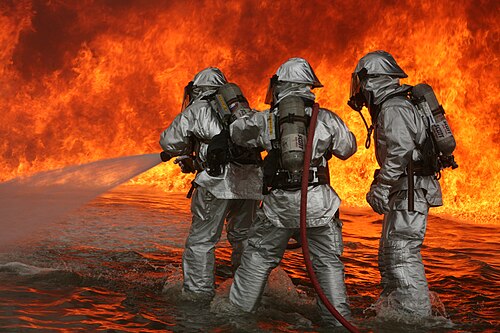Fire
Fire is a rapid oxidation process that releases heat, light, and various reaction products, often including smoke and flame. It is a crucial element of human development, providing warmth, enabling cooking, and driving technological advancement. However, fire can also cause widespread destruction when uncontrolled, leading to property damage, loss of life, and environmental degradation.
Nature of Fire
The nature of fire is defined by the fire tetrahedron, a model describing the four components necessary for fire: fuel, heat, oxygen, and an ongoing chemical reaction. Removing any of these components can extinguish a fire.
Fuel
Fuel can be any combustible material, including wood, petroleum, gas, and plastics. The properties of the fuel, such as its moisture content, shape, and composition, significantly affect fire behavior.
Heat
Heat is the energy source that initiates the combustion process. It raises the temperature of the fuel to its ignition point, the temperature at which it emits vapors that can ignite.
Oxygen
Oxygen supports the chemical reactions that occur during combustion. In Earth's atmosphere, which is about 21% oxygen, most fires derive their oxygen from the air.
Chemical Reaction
The chemical reaction in a fire is typically a form of oxidation, which occurs so rapidly that noticeable heat and light are produced.
Types of Fire
Fires are classified based on the type of fuel burning:
- Class A: Fires involving solid combustibles such as wood, paper, and fabric.
- Class B: Fires involving flammable liquids or gases.
- Class C: Electrical fires, where the use of water to extinguish the fire could be dangerous.
- Class D: Fires involving combustible metals, such as magnesium and aluminum.
- Class K: Fires involving cooking oils and fats in kitchen appliances.
Fire Management
Effective fire management includes prevention, detection, and suppression strategies.
Prevention
Preventive measures aim to reduce the likelihood of a fire starting. These include building codes, fire-resistant materials, and public education on fire safety.
Detection
Early detection of fire is critical for effective suppression. Smoke detectors, heat sensors, and flame detectors are commonly used technologies.
Suppression
Suppression methods vary depending on the fire class. Common methods include water, which cools the fire, fire extinguishers, which can smother or chemically halt the combustion process, and fire retardants, which slow the spread of fire by inhibiting the chemical reaction.
Environmental Impact
Fires can have profound effects on the environment. While natural fires play a crucial role in some ecosystems, promoting biodiversity and renewing vegetation, human-induced fires and uncontrolled wildfires can lead to deforestation, air pollution, and loss of wildlife habitat.
Glossary
- Oxidation - A chemical reaction that involves the transfer of electrons from one substance to another, often producing energy in the form of heat and light.
- Flame - The visible, glowing portion of a fire, which emits light and heat from the combustion process.
- Smoke - A collection of airborne solid and liquid particulates and gases emitted when a material undergoes combustion.
- Ignition point - The minimum temperature required to cause a fuel to undergo combustion.
- Combustion - A high-temperature exothermic chemical reaction between a fuel and an oxidant, producing oxidized products and releasing heat and light.
- Fire tetrahedron - A model explaining the four necessary components for fire: fuel, heat, oxygen, and a chain of chemical reactions.
- Fire extinguishers - Devices used to extinguish small fires by projecting a substance that cools the burning material, deprives the flame of oxygen, or interrupts the chemical reactions occurring in the flame.
- Fire retardants - Substances that reduce the flammability of materials by inhibiting or delaying the combustion process.
| Fire | ||||||||||
|---|---|---|---|---|---|---|---|---|---|---|
|
| Natural disasters · list by death toll | ||||||||||||||||||
|---|---|---|---|---|---|---|---|---|---|---|---|---|---|---|---|---|---|---|
|
Transform your life with W8MD's budget GLP-1 injections from $125.
W8MD offers a medical weight loss program to lose weight in Philadelphia. Our physician-supervised medical weight loss provides:
- Most insurances accepted or discounted self-pay rates. We will obtain insurance prior authorizations if needed.
- Generic GLP1 weight loss injections from $125 for the starting dose.
- Also offer prescription weight loss medications including Phentermine, Qsymia, Diethylpropion, Contrave etc.
NYC weight loss doctor appointments
Start your NYC weight loss journey today at our NYC medical weight loss and Philadelphia medical weight loss clinics.
- Call 718-946-5500 to lose weight in NYC or for medical weight loss in Philadelphia 215-676-2334.
- Tags:NYC medical weight loss, Philadelphia lose weight Zepbound NYC, Budget GLP1 weight loss injections, Wegovy Philadelphia, Wegovy NYC, Philadelphia medical weight loss, Brookly weight loss and Wegovy NYC
|
WikiMD's Wellness Encyclopedia |
| Let Food Be Thy Medicine Medicine Thy Food - Hippocrates |
Medical Disclaimer: WikiMD is not a substitute for professional medical advice. The information on WikiMD is provided as an information resource only, may be incorrect, outdated or misleading, and is not to be used or relied on for any diagnostic or treatment purposes. Please consult your health care provider before making any healthcare decisions or for guidance about a specific medical condition. WikiMD expressly disclaims responsibility, and shall have no liability, for any damages, loss, injury, or liability whatsoever suffered as a result of your reliance on the information contained in this site. By visiting this site you agree to the foregoing terms and conditions, which may from time to time be changed or supplemented by WikiMD. If you do not agree to the foregoing terms and conditions, you should not enter or use this site. See full disclaimer.
Credits:Most images are courtesy of Wikimedia commons, and templates, categories Wikipedia, licensed under CC BY SA or similar.
Contributors: Prab R. Tumpati, MD




